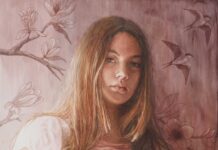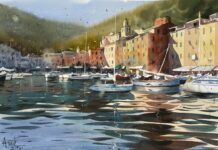Trees offer a number of opportunities for the landscape painter to add value and edge contrast, help move the viewer’s eye around a painting, and provide a pop of interest and detail.

Keiko Tanabe thinks about her trees from the beginning of her process, including them as a vital element of her preliminary value and composition sketch.

By the time she gets to her watercolor paper, she’s worked out edge treatment and placement, so she doesn’t feel compelled to draw every leaf. In fact, sometimes she’ll paint the trees without drawing them at all. “All I have to do is understand the shape,” she says. “I study how the branches come out of the trunk and the type of leaves.”

How Keiko Tanabe Adds Trees to Her Watercolor Landscapes: A Watercolor Tutorial
Keiko starts with the big shapes. When she puts in her background sky, she isn’t worried about covering the area she’s going to fill in later with trees. Her painting style is fast and it isn’t precious. She doesn’t bother saving areas if she knows she doesn’t have to.

After she paints the sky, she adds quinacridone gold to her turquoise sky mixture. With this color, she adds grasses to her painting. She also begins to work into the area of her future treeline.

Now she’s ready to officially begin her trees. But first, she stops and considers the moisture of her paper. “My plan is to create a little more softness in this tree,” says Keiko. So she mists her watercolor paper with her small spritz bottle — one of her most important tools. She’s battling the wind and the heat and she’s constantly touching her paper to see how wet it is and calculating what kind of edge that level of wetness will create.
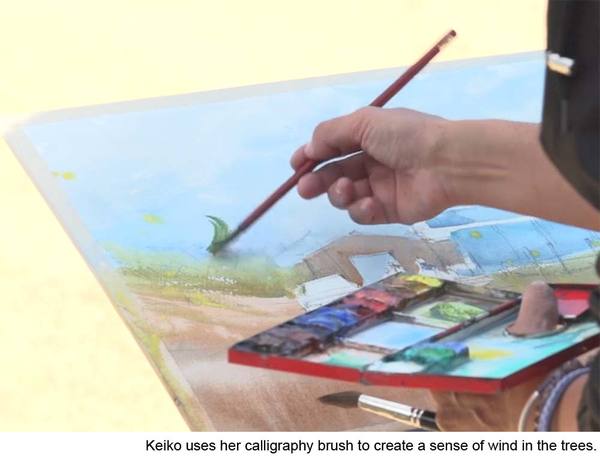
“If the trees have both hard and soft edges, that’s fine. They don’t have to be totally soft,” she says. In fact, Keiko wants this combination to bring contrast and interest to her painting.
She changes the color temperature of her trees as she paints them. She starts with a fairly blue-green hue. As she works, she grays her color and warms it a bit.
She paints her trees quickly and intentionally. She uses her calligraphy brush to paint trees that give a sense of the wind Keiko is experiencing while she’s painting. “I’m making swirls to create the feel of the trees moving in a circular motion,” she says.

It’s at this point she realizes two things. First, she knows the trees in her composition sketch are darker than the ones currently in her painting. The paper is still a bit moist and she mixes a dark mixture of violet and cobalt to use as the underside of her tree line.
It’s also at this point that she moves a bit more toward realism, “I’m trying to show a little more reality, bringing down the trunks and maybe even showing some branches here or there if I can.”
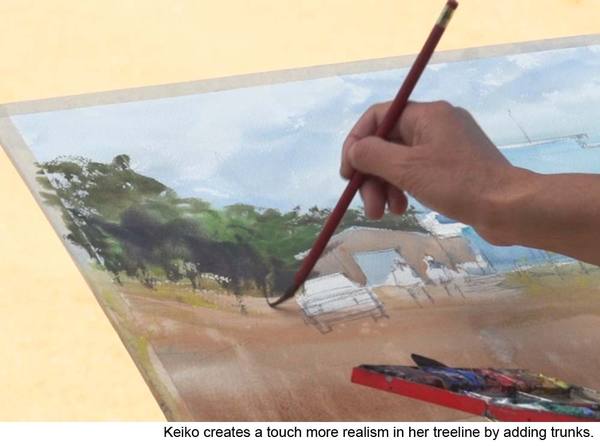
But she doesn’t do this through slow painting. There’s no slowing down. She does what she needs in the quickest way she can. In this case, that means a bit of dry brushwork and scratches with a palette knife.
How to Scratch with a Palette Knife
Keiko uses scratches for more than just her trees. She also uses them to get some lights back in her work without having to slow down and paint negatively around her lights. Again, she’s always looking for methods to paint faster, but still get necessary details where she wants them.
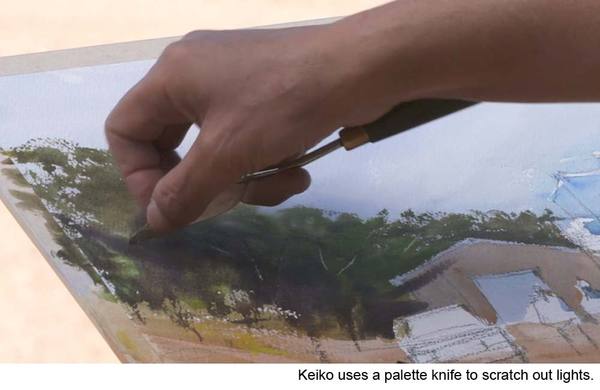
Scratching only works when your paint is still wet. It’s something Keiko acknowledges you’ll have to practice a bit. If you scratch into paint that’s too wet, the paint will seep back into the line and make it darker. If you scratch when the paint is too dry, you won’t get any line at all. If you scratch when the paint is just right, you’ll pull out a lighter line.
Using Trees as Part of the Composition
Keiko knows that as the painter, she gets to choose what she leaves in and what she takes out of her watercolor paintings. She uses trees as a way to take things out.
“There’s a lot of things I’m seeing over there,” she says of the right side of her painting subject, “but it’s not my intent to show them.” Her solution: “I’m just going to fill the space with a tree.”

Keiko also uses trees as a way to emphasize other shapes. “Trees are usually dark in value. So I can use this [the value] to indicate important shapes,” she says.
For example, on the left side of her painting demo, she has a brown barn. She uses the dark treeline behind the barn to emphasize the barn’s shape.

Plein air or in-studio, trees are a wonderful addition to any landscape painting. Watercolor artist Keiko Tanabe frequently uses trees to add interest to her watercolor work. Sometimes they are the main attraction, and sometimes she uses them as important background players. Either way, she plans how to use them and then dives into them confidently.
Keiko shares more about her painting process in her DVD, “Storytelling With Watercolor With Keiko Tanabe.”

